Ryan Hall's Blog, page 302
January 12, 2016
2016 London Marathon Boasts an Incredible Women’s Field
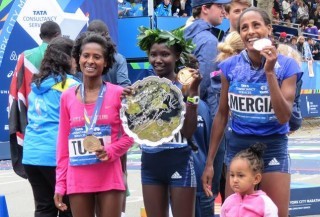
Tigist Tufa (left), Mary Keitany and Aselefech Mergia, seen here after the NYC Marathon, will be part of a star-studded London Marathon field. (Photo: Jane Monti for Race Results Weekly)
(c) 2016 Race Results Weekly, all rights reserved. Used with permission.
With a snappy 16:14 split from 35 to 40 kilometers, Ethiopia’s Tigist Tufa became the surprise winner of last April’s Virgin Money London Marathon, defeating pre-race favorite and two-time London champion Mary Keitany of Kenya by 18 seconds. That victory launched Tufa, 28, to the top echelon of marathon running.
“I was planning to be ready to be tough,” Tufa told reporters after the race.
Keitany, the No. 2-ranked marathoner in the world last year by Track & Field News, got her revenge at the TCS New York City Marathon last November, running away from the field in the final 10K, relegating Tufa to third place and winning by nearly a minute and a half.
“What I can say is that I was very confident in coming to New York City Marathon,” Keitany told the media after the race. “I wanted to come and try to defend my title.”
Tufa and Keitany will again meet at next April’s Virgin Money London Marathon, organizers announced today. The April 24th race features a star-studded field where Tufa and Keitany are only the tip of a massive iceberg of talent. Indeed, the elite women’s field boasts last year’s winners of the Berlin, Chicago, Dubai, London, New York, and World Championships marathons. Five women have broken the 2:20 barrier, while a total of nine have broken 2:22.
“Tigist Tufa showed last year that predictions mean nothing in marathon racing when she beat all the favorites with a thrilling victory,”commented event director Hugh Brasher in a media release. “This year’s line-up is no less exciting with five members of the prestigious sub-2:20 club all set to challenge the champion. With the Rio Olympics around the corner providing an extra incentive to all the elite runners, it is set to be another race to remember.”
The other key contenders from Kenya are Gladys Cherono (2:19:25 PB), last year’s BMW Berlin Marathon champion; Florence Kiplagat (2:19:44), last year’s Bank of America Chicago Marathon winner; Priscah Jeptoo (2:20:14), the 2012 Olympic Marathon silver medalist; and Jemima Sumgong (2:20:48), the 2014 TCS New York City Marathon runner-up. From Ethiopia, three-time Standard Chartered Dubai Marathon winner Aselefech Mergia (2:19:31 PB), and reigning world champion Mare Dibaba (2:19:52) are also in the race.
Moreover, the race will serve as the British trials for the 2016 Olympics. The first two British women to finish the race who have met the 2:31:00 U.K. Athletics qualifying standard will earn provisional berths on the team (U.K. Athletics will announce the team the day after the race). British athletes competing are Sonia Samuels (2:28:04 PB), Freya Ross (2:28:10), Alyson Dixon (2:29:30), Louise Damen (2:30:00), Susan Partridge (2:30:46), Jess Coulson (debut) and Charlotte Purdue (Debut).
The Virgin London Marathon is part of the Abbott World Marathon Majors series and will be the second event in the AWMM Series Xwhich begins at the Boston Marathon on April 18. The current series, Series IX, ends at the Tokyo Marathon on February 28th.
The post 2016 London Marathon Boasts an Incredible Women’s Field appeared first on Competitor.com.
Shoe Of The Week: Hoka One One Vanquish 2
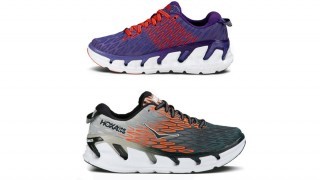
The second edition of the Vanquish is a lot lighter, more flexible and more durable than the original.
Hoka completely overhauled its neutral-oriented Vanquish shoe for 2016 in amazing fashion. Not only is the Vanquish 2 considerably lighter (almost 2 full ounces lighter per shoe!), it also rides more smoothly and is more responsive than the original. It still features a cradle design, in which the foot and interior structure of the shoe is encased on the sides and bottom by a durable two-layer foam shell. The foam closest to the foot provides superior cushioning, while the foam closest to the ground serves up a resilient peppiness. Smooth-riding and impossibly light for a shoe with as thick of a midsole as it has, the Vanquish 2 is remarkably flexible and offers a nice mix of soft landings and energetic toe-offs, especially at moderate to fast paces. (Our wear-testers thought it was sufficient but not quite as responsive at slower paces, too, but it took a while to dial in the correct (lower) cadence with longer ground-contact time.)
The seamless and stitchless TPU-reinforced upper has been redesigned slightly, which our testers thought helped in the fit and forefoot flexibility. (Several testers also liked the color “pop” of the new version.) There are more durable rubber segments on the outsole of the updated version, which should make a longer-lasting shoe and slightly more stable than the first version. (Our testers wavered on how stable the Vanquish 2 really is—some thought it to be moderately stable, others thought it would be best only for strong-legged neutral runners.)
Given the maximally cushioned chassis, a sense of ground-contact proprioception and agility are understandably lacking in this shoe, but that becomes nearly irrelevant once you find your groove out on the run. Our testers found this shoe best for long runs, progression runs and tempo runs, although it is still more than adequate for slower recovery runs—even though it feels slightly less smooth and responsive.
“This shoe was a blast,” said wear-tester Adam Heaney. “It is one of the most responsive shoes I have ever run in. It sets the standard for energy return in a running shoe.”
This is the shoe for you if … you’re looking for a lightweight max-cushioned shoe for half-marathon and marathon training runs.
Price: $170
Weight: 9.8 oz. (men’s 9.0); 8.3 oz. (women’s 7.0)
Heel-Toe Offset: 5mm; 32mm (heel), 27mm (forefoot)
RELATED: Shoe of the Week—Nike Free RN Distance
The post Shoe Of The Week: Hoka One One Vanquish 2 appeared first on Competitor.com.
Living the Dream: Merely Qualifying for the U.S. Olympic Trials Marathon is a Huge Feat
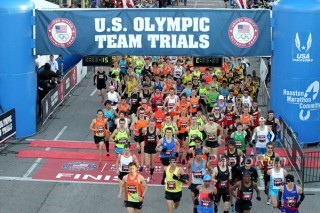
Photo: PhotoRun.net
At the 2016 U.S. Olympic Trials Marathon in Los Angeles on Feb. 13, America’s top professional runners will attract the most acclaim—Kara Goucher, Meb Keflezighi, Desiree Linden, Shalane Flanagan and Dathan Ritzenhein, to name a few—but the less-appreciated paths of the dreamers represent the true heart and soul of this event.
For those outside of the spotlight, the ultimate goal of making it to the starting line will be their Holy Grail. They are parents, teachers, your neighbors, or work full-time. Others represent the future—young, developing runners with sharp coaches who are in the process of gaining valuable experience, often while lacking sponsorship. Still others might be grinding away, perhaps sensing the twilight of their running career, putting off a full-time job or starting a family for just a little while longer.
From top to bottom, all of these competitors are galvanized by their purely intrinsic love for the sport, the spirit of which is being captured for posterity by a dedicated film artist.
“There is no life-changing financial incentive,” says Wendy Shulik of Wendy City Productions, whose is composing and producing a film about the 2012 and 2016 U.S. Olympic Trials Marathons. “They are making huge life sacrifices every day because of their unwavering love for the sport.”
RELATED: Competitor’s 2016 Olympic Trials Coverage
Take for example Olivia Mickle, an effervescent, 24-year-old Sacramento, Calif., native and recent Brown University graduate who competes for the Bowerman Track Club and lives in Beaverton, Ore., where she works full-time as a footwear developer at Nike. Prior to 2016, she had fallen seconds short in two attempts at netting the women’s half-marathon Olympic Trials qualifying standard of 1 hour, 15 minutes flat.
Mickle, who burns with an irrepressible passion, is one of those runners you can already sense will still be brimming with excitement to continue running when she’s 80. She also shares this zeal with her still-fast father, Iain Mickle, a standout masters runner who ran a 2:38 marathon five years ago at age 50.
“He is the perfect training partner for me when I’m in town,” says Olivia. “We develop this deeper sense of connection when we’re out on a run. We don’t have to say anything. It’s something really special that we share and I doubt too many daughters get that experience.”
After a pair of near-misses, Mickle took her final qualifying shot on Jan. 3 at the JAX Bank Half Marathon. This event was organized by the resourceful, Florida-based race director Richard Clark Fannin, who, to his credit, took on a maestro’s role and seized the moment. In two short months, he transcended a small local race known for its fast course into a real barn-burner of an event with national implications, successfully assembling a deep field for the Jacksonville race replete with pacers in an event dubbed the U.S. Olympic Trials Marathon Project.
The fickle weather held out and Mickle made it, reaching the qualifying standard with an official 1:14:15 mark. She was part of a qualifying vortex of sorts. A grand total of 14 women qualified in an event featuring a fast course and pacers. “I really wanted to do this,” Mickle says. “When we all finished together as a big group under 1:15 it was like one giant cluster of happiness. I was so beyond excited. We didn’t really even know each other before the race, but we were all yelling and hugging. It was really great and something I will never be able to forget.”
The men’s field aimed to share in the magic in Jacksonville—as dozens eyed the magical 1:05 barrier with a steely pre-race focus. Roughly an hour later an exuberant wave of accomplishment permeated the men’s field as 27 men in all dipped under the qualifying mark. For most, the act of making the trials is where most of these dreams take place. A massive group celebration like this will not be replicated at the U.S. Olympic Trials Marathon, since only the top three men and women will be selected for the U.S. Olympic team.
Among all U.S. Olympic Trials qualifiers for the 2016 cycle, perhaps the most astounding breakthrough was an electrifying, four-minute half-marathon PR notched by The Woodlands, Texas-based Ryan Miller, 24, who shattered his 1:08 PR and qualified by running 1:04:35 in Jacksonville.
“There were some definite long shots in the race,” Clark-Fannin admits, “but taking four minutes off of his time to qualify really stunned everyone.”
The unassuming but quietly confident Miller has always been an underdog. He ran an unremarkable 9:40 3,200 in high school, and was not recruited to run at any college, though he ended up walking on at and competing for Texas A&M CC. He now runs for Team Green, founded and coached by Dan Green, and works 50 hours per week as a supply chain analyst for Anadarko Petroleum in Houston.
“Richard Clark-Fannin told me the equivalent 10K for the half was 29:05 or 29:10, so it was intimidating at first but it (qualifying) happened,” Miller says. “I did run 29:50 on the track once. I wanted to go out in the top third of the group because that’s where the good stuff happens. When it was over I was … we were just ecstatic. The fourth-place guy was 1:04:25 and I was 19th in 1:04.35. I knew I had it at mile 11 but I couldn’t believe it. Most of us had only said hello before the race but everyone was smiling and yelling and hugging each other afterward. My dad flew out too and hugged me so tightly I couldn’t breathe,” Miller adds.
Miller summed up the appreciation of many on social media two days later: “I want to give a big shout out to Richard Clark-Fannin. In the span of only a couple months, he put together an event for elite and sub-elite runners in the U.S. to chase their Olympic Marathon Trials dreams. From the airport shuttling, to the hotel accommodations, to the elite athlete dinner the night before, (he) and his team went above and beyond to make the JAX Bank Half Marathon an event to remember for all involved. From all the elite athletes that you worked so tirelessly to assist, thank you for all that you do.”
Still, talent, resolve and hard work also require an element of luck, and good fortune had yet to shine on recent University of California graduate JP Slater, who runs for Skechers, is looking at grad schools, and is coached by Cal’s associate head coach Shayla Houlihan. Slater finished within a hair’s breadth of the 1:05:00 qualifying standard at the Rock ‘n’ Roll San Jose Half Marathon in Oct. 2015, but to many observers it was a little more than a narrow miss.
The finishing clock at San Jose clearly read 1:04:58 when Slater crossed the line, but in the end he was given a mark of 1:05:02 as the electronic clock’s digital reading was slightly off from the correct mean time.
“I knew it was close but with about 15-20 meters to go. I saw 1:04:53 and was sure I had it. Meb (Keflezighi) even came over and congratulated me and told me I had made it. For that moment in time I was so happy,” Slater recalls. “Then I found out it was 1:05:02 and I thought, man that was really rough.” Just like that it became a nightmare for Slater.
There was an understandable ripple effect from his supporters on social media, but Slater was undeterred, putting this disappointment behind him. He flew out to Jacksonville from his home in Los Angeles, Calif., determined and very well-prepared. During the race everything seemed to be going perfectly for Slater, who was all business and had no problem rolling along with the sub-1:05 pack in Jacksonville, until disaster struck and he turned his ankle.
“I never felt labored by the pace,” he admits. “I knew I was going to be way under 1:05 but then I jammed my ankle at the eight-mile mark which caused me to have to change my stride.”
That was the beginning of the end for Slater, who tried to gut it out but was now running in pain. He struggled to the finish and recorded another heartbreaking near miss—1:05:05. So while others celebrated wildly around him, he was left to cope with another brutal letdown in the midst of the wild melee of joy. “Today I am on crutches to recover my ankle. I’m also super sick today … and pretty upset about it all,” he said the following day. Slater displayed exemplary class about the fiasco, but the bottom line is he’ll likely have to take his shot in four more years.
Still, personal victories were numerous among the trials qualifiers at Jacksonville and elsewhere. Keely Maguire, a 25-year-old single mother with a 5-year-old son, works in the loan department of a mortgage bank and lives in Newmarket, N.H. The University of New Hampshire graduate competes with New Balance Boston and completes many of her training runs on the treadmill in order to be close to her son. Unsure of how she would fare in the strong field, she easily qualified for the Olympic Trials Marathon at the Jacksonville event. She ended up pulling away from the goal-pace pack a bit, and her speedy time of 1:13:47 in her debut at the distance with relatively moderate training served notice that she could be an emerging star.
More than anything, Maguire feels that running kept her grounded.
“I took a year off after college and my running was struggling because I didn’t have any clear goals or competitive focus,” she says. “I really missed it and need it in my life right now. So I met with my coach (Robert Hoppler) in August and we agreed that I should try to make the half-marathon standard in order to qualify for the Olympic Trials. I’m really excited to do this because I’ve only been training seriously for four months. This is telling me that I am only beginning to scratch the surface of what I might be able to do in the future,” she adds.
There were other inspired stories emerging from Jacksonville, such as Kevin Castille, who at 44 became the oldest men’s qualifier in the field. Juan Paredes qualified officially after it was ruled his Rock ‘n’ Roll San Diego time was not ratified by USATF well after he’d received a congratulatory letter from them. Paredes had to brush off his disappointment and re-qualify to earn a spot at the Olympic Trials and did so in Jacksonville.
While many flocked to the half marathon, other athletes took a more traditional route and met the qualifying standard in the full marathon. One was Malcolm Richards, a gritty, 33-year-old elementary school teacher for San Francisco Charter School in San Francisco, Calif., who ran for tiny St. Olaf University in Minnesota. He is the grinder of the field, who barely broke 15:00 for the 5,000 in college but never gave up on himself and remained a consistent runner and racer for all these years. He qualified for the 2012 U.S. Olympic Trials Marathon with a 2:17, and re-qualified for the 2016 version of the trials with a pair of 2:15 performances.
Richards, a native of Annapolis, Md., also sports a 1:03:26 half-marathon PR and competes for the West Valley Track Club. He is primarily self-coached with a little input from WVTC’s club coach Jack Youngren. “I’ve been putting in 110-115 miles per week and this is the longest uninterrupted, injury-free stretch of training I’ve ever had (18 months). I’ve done the most miles in my life this year.” Though Richards has been on a tear in the local Pacific Association of USATF’s competitive racing circuit, finishing 26th at the USATF Club Cross Country Nationals in December, his name has yet to resonate on a national basis.
“Everything is really coming together and I feel like I am in the best shape of my life,” Richards says. “I’m hoping for a top-20 finish but I’m fitter than I’ve ever been, and I am going to hang on for as long as I can.” He seems to fall into that nebulous category, possessing just enough fitness, veteran savvy, and talent to stay in the mix for a long time.
Jesse Davis of Indianapolis, Ind., a 34-year-old marathoner who manages a Runners Forum store in Indianapolis, was recently named Indiana-USATF’s athlete of the year in 2015. He formerly ran the 800-meter event and steeplechase in college at the University of Southern Indiana but made the jump to the longer distances shortly thereafter and never looked back. Davis has run 19 marathons in his life and also qualified for the 2012 Olympic Marathon trials, but ran these while injured. “I wanted to run the trials when I was healthy,” Davis says.
He required seven attempts to qualify for the then-established 2016 USATF qualifying standard of 2:18:00, with all of his times ranging between 2:18 and 2:23, including marks of 2:18:47, 2:18:26 and 2:18:13. The epitome of determination, he finally nailed a 2:17:59 chip time at the 2015 Monumental Marathon in Indianapolis, but the gun time indicated 2:18:02. This resulted in an appeal to USATF which was eventually granted. “It was one of those sprint finishes,” Davis recalls. “I kept asking myself, did I make it or not? There was two days of deliberation on the iteration of the rules by USATF but I won the appeal and got in.”
It was moot in principle as Davis would have automatically qualified when USATF recently revised the standard to 2:19 in response to IAAF’s softening of the Olympic Games entry standard.
“That didn’t matter, it was a very dramatic build-up and then they opened up the time to 2:19, but I wanted to break 2:18,” Davis explains. “(Going forward) this is probably it for me, I ran in the 50K world championships in Qatar and took 5th, so I might concentrate on ultra-marathon events after this.”
The stories are widely varied but similarly compelling. Regardless, all Olympic Trials Marathon qualifiers will be forged by a common shared tie from earning a place among the stars on the hallowed starting line. When they square off in Los Angeles next month, the odds are long that the dreamers will have a lasting impact on the race or qualify for an Olympic team, but for all of the dreamers the stakes are high.
For some, it’s their last shot, for others, it’s a jump-off point to an amazing future. It matters not. In this tangible way, these athletes make the event more relevant to the world around them. Their humanity will touch a wider audience, tuning in the families, friends, loved ones, co-workers, former coaches and current mentors. These athletes embrace what is the best and brightest about the Olympic Trials and help grow the sport for the fans. This crystallization of years of hard work and sacrifice, such as long runs in the heat, wind or snow, have all been devoted to the act of belonging on the proving ground of the U.S. Olympic Trials Marathon. This fleeting moment in the sun reflects their achievement, manifesting in a members-only, hours-long race that will represent one of the greatest memories in a runner’s career.
The post Living the Dream: Merely Qualifying for the U.S. Olympic Trials Marathon is a Huge Feat appeared first on Competitor.com.
Running’s Tech Boom Is Just Getting Started

The interaction of sport and technology was very evident at the 2016 Consumer Electronics Show Jan. 6-9 in Las Vegas, especially at the massive Intel area. Photo: Brian Metzler
I’ve been telling everyone for years that whatever happened in George Jetson’s technology-enhanced life, we’d one day be able to experience in ours.
The long-running popular cartoon series and 1990 animated film about a family from a futuristic outer space society are ancient history—just like the running shoes, clothes and accessories of the original running boom—but the age of technology is obviously upon us. As 2016 unfolds, a new generation of high-tech running gear is dawning, and some of it would make ol’ George Jetson proud.
This year’s new gear will certainly continue the paradigm shift that has seen running become more intertwined with technology in recent years.
RELATED: The Best Running Tech Products For 2016
In short, the game-changing products and technologies that are emerging have the ability to help runners become more efficient, smarter about training, wiser about recovery and ultimately faster. Although first-generation wearables—heart rate monitors, basic smartwatches, simple step counters and even so-called sleep monitors—have gained traction and acceptance, the latest innovations—from advanced smartwatches to tech-enhanced shoes and apparel to sophisticated gait monitors and running power meters—definitely represent what’s next.
“I think what is apparent is that the world of technology and sport are colliding in a really cool way,” says Chris Ladd, executive vice president of New Balance, which recently launched a Digital Sport division focusing on game-changing digital experiences and wearable technologies. “I think the data, the sensors, the technology available right now allow the athlete to have an unprecedented view of their performance. It’s a really exciting time.”
Ladd points out that New Balance’s expertise is in developing athletic footwear, apparel and accessories, not electronics or advanced technologies. But, he says, that’s exactly why it has forged partnerships with leading-edge tech companies like Intel, Strava, Google and Zepp. It’s through those partnerships that joint understanding of athletic training and improvement can be understood and game-changing products can be developed.
RELATED: What Runners Will Love from CES 2016
The new division will initially focus on three product categories: devices, including a new smartwatch that will allow runners to track workouts and listen to music untethered from a smartphone; embedded technology, such as intelligent sensors integrated into New Balance footwear and apparel; and performance sport, including a sports equipment micro-fob that senses, analyzes and provides feedback of an athlete’s performance.
The first tech-enhanced shoes from Altra and Under Armour are expected to debut by late winter. Using a chip in one of the shoes, the Under Armour Gemini 2 Record Equipped ($150) automatically tracks a runner’s speed, distance, cadence and route and seamlessly downloads the data to the brand’s Map My Run platform.
The Altra IQ ($199), which interacts with iFit wearable tech devices and software, has been designed to provide real-time running analysis and coaching feedback that can make a runner more efficient. It has full-length sensors in each shoe and can tell runners if they’re overstriding, have too slow of a cadence or have a stride imbalance.
“The way technology becomes useful in running is not just by giving runners data but by helping runners use the data for improvement, for example their gait or their fitness,” says Golden Harper, one of the founders of Altra Running. “Our goal wasn’t so much to create a tech shoe, it was to continue with the reasons we started Altra and that’s to help runners improve and reduce the chances of injuries.”
RELATED: First Look: Altra IQ Tech Shoe
The new Stryd chest strap power meter is another good example of modern technology benefitting runners. It measures the power an athlete produces while running, allowing that runner to instantly understand how much effort they’re putting forth—a little or a lot, too much or too little—during a particular run.
Ultimately, it’s a device to help a runner understand efficiency and run at any speed or effort while keeping their power output as low as possible—either by fixing minor form flows, adjusting intensity on the go or developing workouts to promote efficiency, although in theory it could even help a runner choose the most appropriate shoe for a particular type of run.
“There is more and more technology coming into sport and the challenge is to find out what is actually useful and what is noise in the background,” says triathlete Craig Alexander, a three-time Ironman World Champion. “For me, I see two real applications to monitoring power output: working on your efficiency, monitoring it and seeing where it breaks down and being able to make adjustments; and also being able to monitor it and build fitness based on it.”
The post Running’s Tech Boom Is Just Getting Started appeared first on Competitor.com.
America’s 21 Most Scenic Trail Races
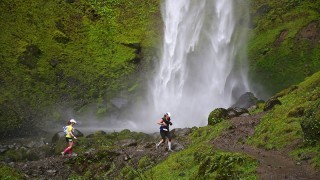
Gorge Waterfalls 50K/100K. Photo: Glenn Tachiyama Photography
You might not be able to look around the entire time you’re racing on trails, but you’ll certainly want to take a peek once in a while at any one of these 21 trail races and revel in the glory that is Mother Nature. We chose the most scenic trail races of various lengths and geographical makeup, all certain to promise both challenging terrain and inspirational, natural beauty.
Orcas Island 25K
Jan. 30, Orcas Island, Wash.
Situated off the coast of Washington among the San Juan Islands in the Puget Sound, Orcas Island is accessible only by ferry or seaplane. The 15.5-mile course winds along some of the softest trails you’ll ever run, past island lakes and over Mount Constitution, through the Sound and other tree-covered islands, and, on a clear day, snow-capped Mount Baker in the distance. (rainshadowrunning.com)
Q50 Races Trails Extravaganza
Feb. 20–21, Franklinton, La.
Choose from six races (10 miles, 5 miles, half marathon, marathon or 50K) over two days at this trail running festival that takes place in Louisiana’s Bogue Chitto State Park. The park offers classic southern terrain, with cypress tupelo swamps, boardwalks, and a variety of greenery and hardwood forests. (Q50races.com)
Mount Mitchell Challenge
Feb. 27, Black Mountain, N.C.
This challenging 40-miler tops out over the highest point east of the Mississippi River, the 6,684-foot Mount Mitchell. Since it starts in the quaint town of Black Mountain at 2,360 feet that means there’s more than 4,300 feet of climbing in the first half of the race. (There’s a 26-mile Black Mountain Marathon option that turns around at 5,340 feet.) Due to its late February date, this race is for the hardy, meaning charging in potential rain, sleet and snow. (blackmountainmarathon.com)
Rock/Creek River Gorge Trail Races
March 26, Chattanooga, Tenn.
Run on the Mullens Cove Loop in Prentice-Cooper State Forest, these races (6.5 and 10.2 miles) combine smooth, buffed-out singletrack with rocky, technical sections—there’s even a “rock garden”—and stream crossings. Hemlock and rhododendron pepper the forest, and fallen leaves often line the trails in this Tennessee gem of a race. (rockcreek.com/rivergorge)
Gorge Waterfalls 50/100K
April 2/April 9, Columbia River Gorge, Ore.
Classic Oregon terrain—old-growth forests, mossy rocks and sometimes technical, rooty trail—make this a beautiful course. The 50K is a one-way route that travels along the Gorge Trail, Pacific Crest Trail and a few others at the base of the Cascades above the mighty Columbia River. (The 100K will be run a week before the 50K race.) (rainshadowrunning.com)
7 Sisters Trail Race
May 8, Amherst, Mass.
This 12-mile race travels on singletrack on a portion of the New England Scenic Trail, a 215-mile trail that runs from Connecticut to the Massachusetts/New Hampshire border. An out-and-back tour of lovely New England in the springtime, the trail passes by Mount Holyoke and Bare Mountain. The race donates net proceeds to preserving wildlife of Mount Holyoke Range State Park. (7sisterstrailrace.com)
Ice Age Trail 50M, 50K and Half Marathon
May 14, LaGrange, Wis.
Run in the Southern Kettle Moraine Forest amid terrain carved out by glaciers more than 10,000 years ago, the geologically unique area changes from prairies to forests to craggy rock. There’s no shortage of water either, with small bodies of water carved out by glacial movement. (iceagetrail50.com)
The Dipsea Race
June 12, Mill Valley, Calif.
This historic 7.4-mile race that first started in 1905 begins in downtown Mill Valley, north of San Francisco, and crosses over the southern flank of Mount Tamalpais before heading into Stinson Beach. The wild course passes through Muir Woods and into open vistas of the Pacific Ocean. (dipsea.org)
Hardrock 100
July 15–17, Silverton, Colo.
It’s tough to get into this 100-miler, but if you do, be prepared for not only the hardest race of your life (you’ll cross 13 passes between 12,000 to 13,000 feet in elevation, and one over 14,000 feet), but also the most stunningly beautiful. The rugged, jagged San Juan Mountains provide a massive and awe-inspiring backdrop. (hardrock100.com)
Grand Island Trail Marathon, Half Marathon and 50K
July 23, Grand Island, Mich.
Running along the Great Lakes shoreline of Grand Island in Northern Michigan is part of the allure of these scenic races. Sandstone cliffs, hardwood forests and breezes off Lake Superior add to the beauty here. The island is about a half-mile from Munsing, Mich., and reachable by ferry. (greatlakesendurance.com)
Crow Pass Crossing
July 23, Girdwood, Alaska
This challenging 22-mile race is run on the rugged Crow Pass National Historic Trail in Chugach State Park, north of Alyeska and southeast of Anchorage. It offers up a tour of the Eagle Glacier, forging across the Eagle River partway through and ends at the Eagle River Nature Center. (alaskamountainrunners.org)
The post America’s 21 Most Scenic Trail Races appeared first on Competitor.com.
January 11, 2016
The Strategist: Desiree Linden Eyes a 2016 Olympic Berth
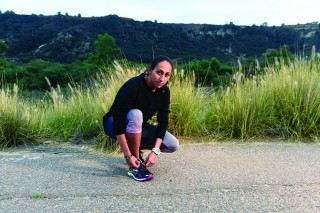
Photo: Scott Draper
There are runners who run smart or bravely or on instinct. Marathoner Desiree Linden prefers a methodical approach.
At the start of the 2015 Boston Marathon, Linden knew that Shalane Flanagan’s aggressive pace the year before—one that winner Rita Jeptoo had described as being “like fire”—had been her downfall.
A woman of strength not speed, Linden would have to run a pace that would stiffen the legs of her competitors and keep them from pulling away from her in the last 4 miles. So the diminutive runner took the lead from the start and locked into her rhythm, battling the cold, rain and wind, her furrowed eyebrows telegraphing a forceful concentration.
She held that lead for just over 23 miles before three other runners found an extra gear and pulled away. Linden took fourth place and ran 2:25:39. She wasn’t disappointed. It was a good fight and a good race. Linden is a runner that uses the phrase “learning experience” about her worst results without the accompanying twinge of bitterness.
“As the distance goes up, a race becomes about far more than talent,” says Kevin Hanson, Linden’s longtime coach and one of the two brothers behind the elite training group Hansons-Brooks Distance Project based in Rochester, Mich. “Training goes into it, race strategy goes into it, even how you think a competitor will compete is factored in. Desi’s a real student of the game. She likes the chess match. She never panics, she plots.”
These are skills Linden will use to her advantage when she competes at the U.S. Olympic Trials Marathon—the race that will determine who goes on to wear the red, white and blue in Rio—on Feb. 13. She knows the way a race will unfold from the start line, the probability of each racer’s next move, the likelihood of a surge being a tactical move or something spawned from overexcitement. She has the confidence to let the runners who run too fast go and the gumption to lead races when everyone else is hesitant. There is no concise Plan A or Plan B—Linden is too methodical for that.
RELATED: Desi Linden Talks About Her Pre-Olympic Trials Marathon Build-Up
Maybe it’s the reason she majored in psychology. That stoic determination—planning, plotting, removing emotion from the job that needs to be done—is what makes Linden a “silent-but-deadly pro,” according to her former college teammate Amy Cragg. She goes quiet when she has bad days and she’s never boastful about the good ones. Her focus is on the job—not the limelight.
The post The Strategist: Desiree Linden Eyes a 2016 Olympic Berth appeared first on Competitor.com.
Awesome: Runner Maps Star Wars Characters on Strava
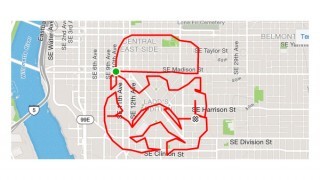
Star Wars mania has gripped a runner and Strava user in Portland, Ore.
Gene Lu has gotten creative with his runs, mapping a Stormtrooper and C3PO during recent runs. The Stormtrooper run was just more than 10 miiles, while the C3PO run totaled 17.4 miles.
The Star Wars franchise has been all the rage recently with the release of Star Wars: The Force Awakens last month.
RELATED: Tech Trends: An Introduction to Strava
The post Awesome: Runner Maps Star Wars Characters on Strava appeared first on Competitor.com.
The Best Running Tech Gear of 2016
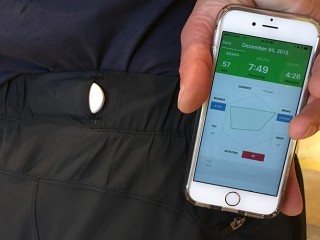
Wearable tech is a red-hot category in running. A variety of newfangled products allow you to track, analyze and compare training and racing data in ways never before possible, except maybe in a lab setting. What can we expect from running tech in 2016? Here’s a closer look:
Photo Gallery
1 of {count}
Back to Start
View Larger Image

Stryd Powermeter
Power is the key metric for measuring performance in cycling. Stryd is the first true power meter for running, a tool that will ultimately measure a runner’s efficiency. The Stryd chest strap sensors track a variety of data, delivering heart rate, movement, form, altitude and power values to its app and many smartwatches. Why is power important? Power is your actual effort. Heart rate climbs beyond your performance potential with increasing temperatures. Heart-rate sensing lags with rapid terrain and pace changes (think intervals or hills.) On longer steady state runs, maintaining consistent power will keep you dialed into true effort. Stryd’s power value is in real time, with no data lags like most heart-rate monitors. ($199; stryd.com)
View Larger Image

Lumo Run
This sensor and app offers real-time lab-grade running form metrics focused on the pelvis and hips. Lumo Run is waterproof and machine washable, has a long battery life, multi sensors and sits comfortably in the waist band of the Lumo shorts or 3/4 tights. It records or live transmits detailed bounce, brake, rotation, tilt, stride length, cadence, ground contact and hip drop information to the Lumo app. The app has real-time audio cues, and yes, you can focus them on one area needing particular work to prevent info overload. After the run you can review a graphic representation of your form and the data. We did a short test and clearly need to work on pelvic rotation, tilt and drop! Available April 2016. (Lumo shorts or ¾ tights with sensor $150; lumobodytech.com)
View Larger Image

Epson RunSense SF-810
This is Meb Keflezighi’s training tool of choice. It’s all about serious workouts, with no phone notifications, step counting or sleep tracking. Meb uses it to focus on cadence and stride length. It has very accurate distance from a calibration of GPS and stride length for tunnels, indoors, and twisting trails with poor GPS strength. We appreciate a very nifty feature that allows setting multiple auto lap distances (like at 5K, 10K, 15K in a half) in addition to every mile/km as well as a target pacing within a range. The screen is not particularly large or bright, so for older eyes setting no more than two data fields per screen is advised. ($230 (SF-710 without wrist heart wrist rate monitoring) or $300 (SF-810 with wrist heart rate monitoring) epson.com/Runsense)
View Larger Image

Altra Running IQ Powered by iFit
One of the world’s first tech-enhanced running shoes, the IQ is a zero-drop running shoe with an integrated chip for sensing metrics of foot strike, cadence, impact force and form. The required companion app or iFit watch will provide simple form cues to act on the data while on the run. The platform has progressed considerably toward its 2016 launch from what we could see in a live demonstration. (altrarunning.com )
View Larger Image

RunScribe Pro
Whereas many of the new run data technologies are focused higher on the body, RunScribe focuses on capturing data where the rubber hits the road—at your feet. Two tiny pods clip to your shoes and record motion data for analysis later. There is no real-time feedback or display to look at the data on the run, but there is a considerable amount of data available after being synched. For the technically minded and those involved in fitting shoes, coaching and preventing and treating injuries, you can derive a wealth of biomechanical information. Beyond the basics of pace, cadence, stride length and contact time, advanced metrics such braking, impact, footstrike and pronation along with stance velocity and excursion are available. Graphically compare runs for any factors, and examine metrics for your different shoes. It’s a bit overwhelming for most but powerful for some. ($149 (RunScribe Pro, single pod) or $239 (RunScribe Pro2X); runscribe.com)

Suunto Ambit3 Vertical
The name says it all. It’s everything but the kitchen sink for the vertically minded runner, cyclist and triathlete. It displays real-time ascent, descent, incline percentages and vertical speed. It adds another dimension to trail running, mountain running or skiing. Load and then follow a route and the Vertical will keep you informed on your climb and show what’s next. Afterward, easily create and share a 3D topo map movie of your journey, complete with key data and pictures taken along the way. Run “power” metrics can be displayed on the watch using the optional, new Stryd Powermeter chest strap. ($469, $519 w/HR strap, suunto.com)
View Larger Image

Soleus Signature Series Collection Watches
Soleus is releasing some fun red, white and blue pro model signature watches as its sponsored athletes pursue their 2016 Olympic quests. Signature watches include the Kara Goucher GPS One ($89), Nick Symmonds Contender ($75) and Alysia Montano Chicked ($65). Available February 2016. (soleus.com)
View Larger Image

UnderArmour SpeedForm Gemini 2 Record Equipped
UnderArmour has entered the growing high-tech shoe business, announcing the late-winter launch of the SpeedForm 2 Gemini Record Equipped. The shoe, embedded with a sensing chip, tracks a plethora of data in real time while tethered to a watch or phone or it can be used device-free. The data is automatically synched to the Under Armour Record app. The neutral-oriented Gemini 2 Record Equipped has a 10mm heel-toe offset and weighs about 10.4 oz. (for a men’s size 9.0) and carries a $150 price tag (about $20 more than the standard Gemini 2). Photo: Steve Godwin
View Larger Image

Polar A360
Polar recently launched the very sleek and stylish A360 (pictured), a color screen heart-rate sensing, activity and sleep band. A comfortable 24/7 companion, the A360 ($199) has smartphone notifications and can feed data to the Polar Flow training platform. The M400 GPS run watch ($230 with HR strap) now includes access to the higher end V800’s Training Load and Recovery Status metrics on the Polar Flow app and website. We found the Polar Flow platform to be a superbly designed and a comprehensive training and activity platform. The M400 and V800 recently were upgraded with Strava integration and support for Android in addition to iOS smart notifications. The M400 now comes in pink and blue. The V800 ($520 with HR strap) was updated for open water swim metrics. (polar.com)
View Larger Image

Garmin fenix3
Garmin introduced three new fenix 3 models at the CES show: a titanium bezel and band version, a version with interchangeable leather and nylon straps, and most interestingly, the first fenix 3 with Garmin’s new Elevate wrist based heart rate monitoring ($600). Fenix heart-rate users will be able to track their activity and heart rate 24/7 along with their intensity minutes from the wrist with no chest strap required. Through a software update, all fenix 3 users get access to Garmin’s Run Dynamics and physiological measurements when using the optional HRM-Run or Tri ($50) chest heart rate band. (garmin.com)
View Larger Image
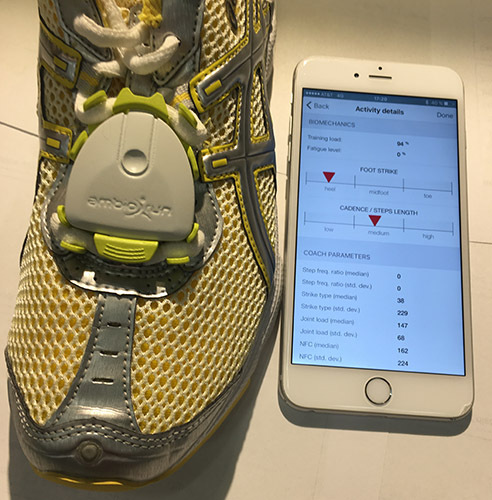
Ambiorun
Ambiorun is a foot pod that captures metrics such as stride length, cadence, strike type, ground contact time, impact load and rotation. Its app also calculates recovery and optimum time until the next training activity. In addition to pace and heart rate, it also claims to factor the effects of joint loading into your training load and recovery. We liked that in addition to live app-based feedback, Ambiorun can be used stand-alone and programmed to provide vibration form feedback alerts. It will be available in April. ($179, ambiorun.com)
View Larger Image
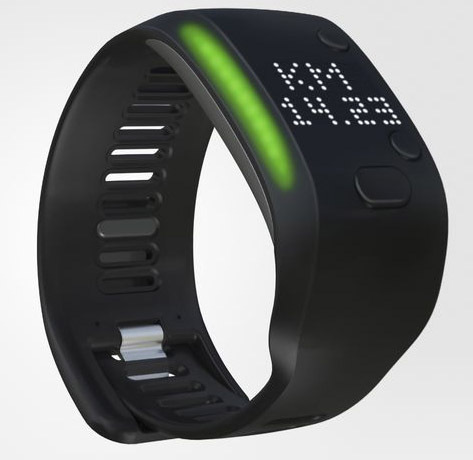
adidas miCoach FitSmart
FitSmart is a reliable, heart rate-focused activity band that can also be paired to run apps and Bluetooth GPS watches (but not Garmins). We liked its very accurate indoor distance accuracy calibrated via the Train and Run app’s GPS. More than just an HR/activity/distance tracker, it can also coach you through heart-rate focused run training, strength, and flexibility programs. ($150; micoach.adidas.com)
View Larger Image
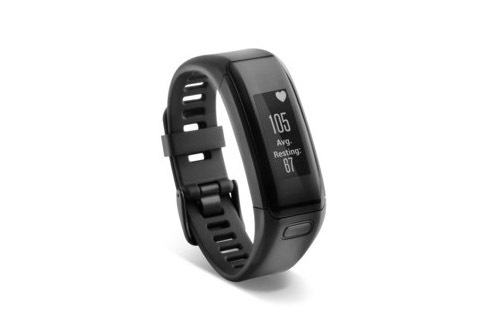
Garmin VivoSmart HR
An activity band for Garmin fans that can serve as a wrist-based heart-rate monitor with the ability to receive call, text and other phone notifications and do more with your phone. It seamlessly sends heart rate data to your workout on Garmin watches. No chest strap or set up required, just turn on the simple “rebroadcasting” mode. ($150, garmin.com)
View Larger Image

TomTomSpark
We took a look at a new family of well-priced, attractive GPS run watches from TomTom just now coming to market. All the Sparks have GPS, activity and sleep tracking, intervals and multi-sport mode. The Sparks focus on simplicity with an elegant interface and single “joystick” button operation. The Spark Cardio +Music ($249) has wrist-based heart rate and can store and play up to 500 songs through Bluetooth headphones. The Spark Music ($199) leaves out the wrist heart rate but keeps the tunes. The Spark ($149) is a straight GPS watch. Narrower and 37 percent lighter than the previous TomTom line, they have interchangeable color straps. (tomtom.com)
View Larger Image
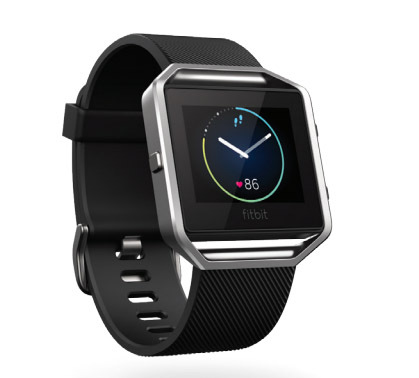
FitBit Blaze
Fashion meets all day and any activity. The Blaze includes sleep-tracking and animated on-screen FitStar workouts. The high-resolution color screen tracker unit comes with a silicone band and can be personalized with watch faces, different frames, several colors of leather and even a stainless steel band. Recognizing that many carry a phone while exercising, Blaze connects to your phone for GPS-based distance and pace along with text, call notifications and music control. SmartTrack detects activity type and combined with multi-sport algorithms and 24/7 heart rate monitoring claims to give a more precise total picture of exertion and movement intensity. ($199 and up; fitbit.com)
View Larger Image
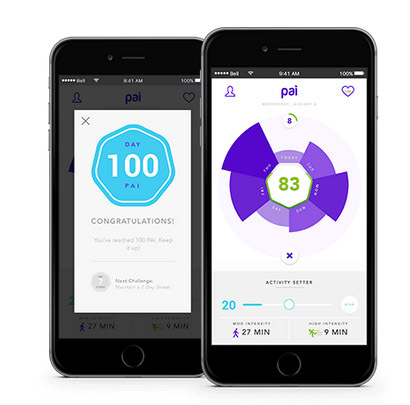
Mio Global PAI Index, Slice HR Activity Band
Mio Global introduced the Personal Activity Intelligence (PAI) index at CES along with the Slice Activity Tracker. Based on research on more than 60,000 people over 20 years, the PAI index, 100 being the target goal, is highly personalized based on your demographics, activity levels and especially your heart’s response to activity. PAI claims to take into account far more than the usual step count and distance to set your PAI. We see the PAI index as potentially helping guide decisions on upcoming workout intensity based on more than just the “schedule”. PAI will be available in January as a metric in the Mio Go app for existing Mio bands. PAI will be displayed directly on the new Slice Activity Tracker when it launches later in 2016.
Related Galleries

7 Transformative Pieces of 2015 Running Tech

7 Runner-Friendly Lights for Nighttime Workouts

More Galleries
The post The Best Running Tech Gear of 2016 appeared first on Competitor.com.
January 10, 2016
Sneak Peek: Must-Have New Running Shoes and Gear for 2016
We checked out the latest and greatest new running gear at the 2016 Outdoor Retailer Winter Market trade show Jan. 6-8 in Salt Lake City. Here are 20 of the best shoes, clothes and accessories we spotted. It will all be available in stores in 2016, some items by springtime, some by late summer. (Be sure to check out other 2016 highlights in the links below.)
RELATED: 40 Shoes You’ll Want to Check Out in 2016
VIDEO: What Runners Will Love From the 2016 CES Show
VIDEO: First Look—Altra IQ High-Tech Shoe
Photo Gallery
1 of {count}
Back to Start
View Larger Image

Brooks Mazama, $140
This new trail running speed demon features a sticky rubber outsole, a full-length propulsion plate and a slightly softer top layer of midsole foam and a firmer bottom layer. (9.7 oz., 6mm heel-toe offset) (Available July exclusively at REI.)
View Larger Image

GU Carmel Macchiato Energy Waffles, $2
GU is adding a yummy crunch to their line of gels, chews and drink mixes with its new Energy Waffles. It tastes like snack food, but works like an energy food thanks to having GU's workout-boosting profile of amino acids to help reduce fatigue and muscle damage. Did we mention they tastes really good too? (Available in late January.)
View Larger Image

Saucony Razor Ice+, $180
Utilizing an innovative new winter outsole technology from Vibram and a weatherproof cover, the Razor is the ultimate winter running shoe. Built off of the Saucony Perergrine trail shoe design, it has a waterproof zip-up enclosure that seals off inclement weather at the ankle. The aggressive outsole tread features Vibram's Arctic Grip compound, which is designed to offer reliable traction on cold wet rocks and snowy, icy surfaces. (11.6 oz., 6mm heel-toe offset) (Available Sept. 1.). Photo: Brian Metzler
View Larger Image

Nathan Exo Shot, $35
Nathan says its new "hands free" Exo Shot handheld hydration vessel is the most effortless way to carry water on the run. Simply cinch it around your palm and forget about it. The bottle collapses as you go, but also has a rigid base to make it easier to stuff into pack pockets. It holds 12 oz. of fluid and has a bite valve. Photo: Allison Pattillo
View Larger Image

Adidas Kanadia, $80
The adidas Kanadia 8 TR is a completely new trail runner with a bold look and killer price tag. It has an aggressive outsole for optimal traction but a light, flexible design for agile off-road running. (9.7 oz., 8mm heel-toe offset) Available in June 2016. Photo: Sam Winebaum
View Larger Image

Arc'teryx Trino Jacket, $225
Generous, easy access, back stash pockets are combined with a draw cord so you can carry food, phone, gloves, hat and more (without bouncing) in the update to this cold-weather running jacket. The wind-blocking, water-resistant front and shoulder panels remain, plus the back and side panels are now DWR coated for more weather protection. Photo: Allison Pattillo
View Larger Image

Skechers GoTrail, $110
Skechers continues to evolve its trail running line. The new GoTrail has more cushioning than ever before—although still less than the GoTrail Ultra 3. It shares the same aggressive knobby outsole as the GoTrail Ultra 3, but the GoTrail also has a forefoot protection plate. (9.6 oz., 4mm heel-toe offset) (Available July 1.) Photo: Brian Metzler
View Larger Image

SmartWool Phd HiFi Training Beanie, $32
This may look like a basic black beanie, but it is oh so much more. Not only is it made from Smartwool's new DWR-coated, nylon/merino blend, the two diagonal temple slits are made to accommodate the arms of glasses and sunglasses for fog free lenses. Photo: Allison Pattillo
View Larger Image

The North Face Better Than Jacket Winter Jacket, $130
Already a favorite among weight saving trail runners, The North Face has winterized its tried and true Better Than Naked Jacket by adding a sleek layer of insulating and wicking fabric to the body. It's like running in your favorite vest without the bulk.
View Larger Image

RX Bars, $2.25
RX Bar is calling its new line of energy bars "the whole food protein bar," and with good reason. They're made from made only the whole food ingredients listed on the front of the packaging. They're also soy-, dairy- and gluten-free, and none have any added sugar. They are available in eight flavors: chocolate sea salt, pumpkin spice, coffee chocolate, coconut chocolate, peanut butter, blueberry, apple cinnamon and min chocolate. Photo: Brian Metzler
View Larger Image

Voormi Tech Tee, $70
This Colorado company uses all sorts of cool technologies to make merino wool even better, like in this seriously lightweight, soft (read: Not scratchy) short sleeve silhouette for women. Photo: Allison Pattillo
View Larger Image

Montane Spine Jacket, $399
There's a burly 268-mile mid-January trail race in the U.K. called the Spine Race—runners pass through five manned checkpoints and get seven days to reach the finish line. As title sponsor for the event, Montane created a full line of lightweight, waterproof and breathable winter endurance apparel, including the Spine Jacket and coordinating pants and a cap. The jacket, made from Gore-Tex Active, weighs in at 10 oz. for men and 9 oz. for women. Photo: Allison Pattillo
View Larger Image

New Balance Fresh Foam Gobi, $95
This new light and fast trail running shoe is built off the Fresh Foam Zante v2, but it has a trail-specific outsole, an interior bootie construction, a reinforced toe and a slightly more durable upper. (9.5 oz., 6mm heel-toe offset) (Available July 1.) Photo: Brian Metzler
View Larger Image

Saucony Ridge Runner Base layer LS, $88
Wool and Primaloft are combined in a dreamy ribbed knit for your new favorite cold-weather running zip tee. It has a long fit as well as longer sleeves with thumbholes for maximum coziness and easy layering. Photo: Allison Pattillo
View Larger Image

Columbia Trail Flash Hybrid Jacket, $90
Sleek, baffled insulation at the chest and back makes this buttery soft full-zip jacket ideal for layering on colder days or worn on its own in milder conditions. Treated to resist stains and odors, its function gets a fashionable pop with ruching on the arms and a hidden reflective pattern. Columbia recently became the official title sponsor of the Ultra-Trail du Mont-Blanc races in Chamonix, France, and will continue evolving its trail running gear with inspiration from that event. Photo: Allison Pattillo
View Larger Image

Suunto Ambit 3 Vertical, $469
The latest version of the Ambit 3 has everything but the kitchen sink for the vertically minded runner, cyclist and triathlete. It displays real-time ascent, descent and vertical speed, which means it's also a great watch for alpine and backcountry skiing. Load and then follow a route and the Vertical will keep you informed on your climb and show what’s next. When you're done, you can easily create and share a 3D topo map movie of your activity, complete with key data and pictures taken along the way. ($519 w/HR strap) Running “power” metrics can be displayed on the watch using the optional Stryd Powermeter chest strap ($199, sold separately). (Available in Jan. 2016) Photo: Brian Metzler
View Larger Image

Brooks Cascadia 7" Short, $65
This new trail running short is made from a super-durable but extremely pliable farbic. It has a comfortable flat-knit waistband, two side pockets (one zippered). (Available exclusively at REI stores in late summer.) Photo: Brian Metzler
View Larger Image

Smartwool Run Ultra Light Micro, $16
Smartwool has incorporated its patented ReliaWool technology in high impact areas of this merino/nylon blend sock and two elastics for greater stretch and flexibility. Mesh ventilation zones are specifically placed for optimum temperature regulation and moisture management. (Availble in mid-June.) Photo: Brian Metzler
View Larger Image

Honey Stinger Gluten-Free Organic Waffles, $1.49
With Honey Stinger's new organic waffles, no gluten is no problem. Available in salted caramel, cinnamon and maple flavors the single-serving packaged waffles are also nut- and dairy-free with a scrumptious taste and texture—meaning they don't taste gluten-free!. (Available in mid-Jan.) Photo: Allison Pattillo
View Larger Image

Mountain Hardwear 32° Tight, $85
These stretch fleece winter weight tights have you covered, and that's the point. Designed with a higher waist (that can also be folded over for a lower fit), these perform double duty as a layering piece under skiing and snow boarding clothes as well as on their own. The higher waist means no layering gaps so you stay toasty. Photo: Allison Pattillo

More Galleries
The post Sneak Peek: Must-Have New Running Shoes and Gear for 2016 appeared first on Competitor.com.
January 9, 2016
Video: What Runners Will Love From CES 2016
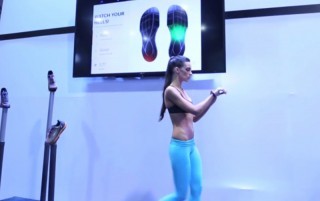
The annual Consumer Electronics Show (CES) took place this week in Las Vegas, and we were there to check out everything that endurance athletes will want to get their hands on. From high-tech shoes to data-collecting wearables to innovative headphones and even dog-friendly GPS trackers, here’s an inside look at the next wave of technology for the active lifestyle.
RELATED: First Look: Under Armour SpeedForm Gemini 2 Record Equipped
RELATED: First Look: Altra IQ Tech Shoe
The post Video: What Runners Will Love From CES 2016 appeared first on Competitor.com.
Ryan Hall's Blog
- Ryan Hall's profile
- 21 followers



